
Earlier this year, Squash Stats took a look at all the number 1 players from 1975 to the present day. For more details on this article please see A Graphical History of the PSA Number 1’s (1975 – 2020). That article provides some interesting insight into the greatest squash players since the formation of the PSA and an official ranking system of squash players. We looked at players with the most number of months at the number one spot, countries with the most number one players, as well as a few other natural questions one might have about the history of world number ones. By doing so we were able to compare players at the pinnacle of the game from different generations. This however is a very narrow view of how players perform over a long period of time. Players, for example, can still be part of the all-time greats and never achieve the top spot in the sport. Presented here is an analysis of the top 10 ranks for both male and female PSA players. This can provide us with a better understanding of the quality, longevity, and consistency of the players’ career. We also look at the dominance of the top 10 ranks by country.
A Few Notes on the Data
Before we get into looking at the data, a few points should be made clear about the data used in this article.
Data Source: As with most of our blogs, we use data from Squash Info – the definitive squash resource, a website that provides a wealth of information on match results, ranking, fixtures etc.
Time-Limited Data: The availability of the ranking is limited as you look back historically. Squash results and rankings were not always digitized. Squash Stats were only able to obtain reliable data as far back as 2000 and thus this is the historical limit of data that we use. Again, all statistics below are for top 10 players since the year 2000. If pre-2000 top 10 data becomes available in the future this article will be retrospectively updated.
Rapid Fire Top 10 Stats
Here are a few overall stats to start with:
- Number of players to make it to the top 10:
- Male: 50 players
- Female: 41 players
- Number of players to make it to number 1:
- Male: 15 (30% of top 10 players)
- Female: 12 (29% of top 10 players)
- Players with the most months in the top 10:
- Male: Nick Matthew (165 months)
- Female: Nicol David (177 months)
- Youngest player in the top 10:
- Male: Ramy Ashour, aged 19.1, ranked #9, November 2006
- Female: Nour El Sherbini, aged 16.6, ranked #7, June 2012
- Oldest player in the top 10:
- Male: Nick Matthew, aged 37, ranked #8, March 2018
- Female: Suzanna Horner, aged 38.8, ranked #9, December 2001
- Countries with top 10 players:
- Male: 18 countries
- Female: 13 countries
- Country with the most top 10 players
- Male: Egypt (13 players)
- Female: England (14 players)
- Country with the most player-months in the top 10
- Male: Egypt (844 months )
- Female: England (786 months)
- Current Country Dominance
- Male: Egypt with ~50 % of all annual player-months
- Female: Egypt with ~ 40% of all annual player-months
- Most Dominant Month:
- Male: Egypt, 2016 – 2018, with 7 players in top 10 (this occurred on 10 occasion)
- Female: England, December 2000 with 7 players in the top 10
Players’ Number of Months in the Top 10
One of the best metrics to determine the quality and longevity of a player’s career is the amount of time a player spends in the top 10 ranks. The following plots accumulate the number of months each player has in the PSA top 10 ranks over the last 20 years. The players’ names are indicated on the y-axis and their respectively accumulated number of months in the top 10 is on the x-axis. Shown are the top 15 players for each gender who have spent the most time in the top 10.
In the male category, it can be seen that Nick Matthew has the most number of months in the top 10 with a total of 165 months (13.75 years). Nick Matthew first entered the top 10 in March 2004 ranked at number 10. He first turned pro in 1998 and retired in March 2018 spanning a career of 20 years. He therefore spent 68% of his professional career in the top 10. This record of the most number of months in the top 10 is close to being broken by Gregory Gaultier who has 164 month in the top 10. Perhaps with Gregory Gaultier playing this season he can overcome Nick Matthew’s record in this category. Mohamed El Shorbagy and Tarek Momen are the only other players who are on the plot that are currently still in the top 10 and thus have potential to move up this table.
As of September 2020, Peter Barker and Tarek Momen are the only players that have not reached the number one spot. Clearly there is a link between a player’s longevity in the top ten players and achieving number one at some point or another. This concept will be further developed later in the article. James Willstrop and Gregory Gaultier are the only players in the plot that are still playing but not ranked in the top 10 players.
It should also be noted that players like Jonathan Power, John White, and Peter Nicol were in the top 10 prior to 2000, however, as mentioned previously, this data is not included. Thus, if all the data was included, their bars would likely be longer and they would probably be higher up in the plot.

It is no surprise to see Nicol David topping the women’s plot with 177 months (14.75 years) in the top ten PSA ranks. She has an additional 39 months (3.25 years) over the next nearest player on the plot. The next two spots are filled up by Rachael Grinham and Laura Massaro who have a similar number of months in the top 10. Nour El Sherbini and Joelle King are the only players in the plot that are currently still in the top 10 players and thus have potential to move up the ranks. Rachael Grinham and Alison Waters are still currently playing PSA squash but are not ranked in the top 10. In contrast to the male players, there are much more players that have not made it to number 1. This is most likely due to the fact that Nicol David dominated this spot for so long preventing other players from achieving this. Nicole David, Laura Massaro, Rachel Grinham, Natalie Pohrer (nee Grainger), Raneem El Welily, and Nour El Sherbini are the players that have made it to Number 1.
Again it should be noted that players like Natalie Pohrer (nee Grainger), Sarah Fitz-Gerald, Susan Devoy, and others were in the top 10 prior to 2000, but pre-2000 data is not included here.

The following plot combines the two plots above whereby the colour of the bar indicates the gender of the player. This illustrates and compares the players from different genders and how successful they were in maintaining a top 10 rank.

We can also look at the percentiles of the number of months in the top 10. The plot below illustrates this with the important percentiles (10%, 25%, 50%, 75%, 90%) shown in a table in the bottom right corner. An example of how the graph can be read is as follows: 50% (y-axis) of players that make it to the top 10 ranks remain there for less than 27 months (x-axis) for male players and 46 months (x-axis) for female players. This 50 percentile also represents the mean length of time players remain in the top 10. For the 10% to 90% percentiles on the y-axis it can be seen that the female line lies to the right of the male line. This indicates that in general female top 10 players remain in the top 10 rank for a longer period of time when compared to male players. On the upper extreme of the percentile (>90 %) the male and female percentile are more similar.

Countries with Top 10 Players
In total there are 19 countries that have had top 10 players from 2000 – 2020. The breakdown of the number of players per country is illustrated in the bar chart below for each gender. England clearly has the most top 10 players closely followed by Egypt. It can be seen that 18 of the 19 countries have had male top ten players, USA being the only one that did not have a male top 10 player. Also, 13 of the 19 countries have had female top 10 players. Considering only the number of top 10 players produced by each country in the last 20 years, there have been just three nations competing for dominance of the top 10 ranks, namely England, Egypt, and Australia.

The following plots illustrate the accumulated number of player-months in the top 10 by each country. For a given month, if there are three players from a particular country in the top 10 rankings, then that country is awarded three player-months for that particular month. This is repeated for all months from 2000 – 2020, and the number of months per country are accumulated.
Egypt has by far the most number of player-months in the top 10 in the male category. In second position with approximately 70% that of Egypt is England. In third place with another large drop is France which is followed by Australia.
The same two countries are at the top of the female table, although their positions are reversed. England has by far the most number of player-months followed by Egypt which has about 55% that of England. In third and fourth place is France and Malaysia.

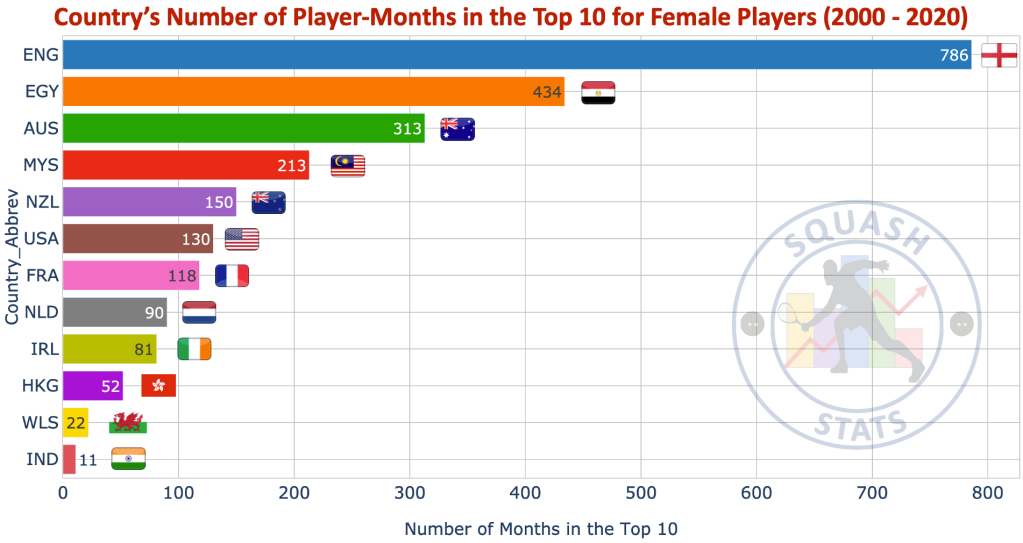
The Rise and Fall of a Country’s Top 10 Dominance
The above plots summarise the countries’ number of top 10 players over a 20-year period (2000 – 2020). However it is clear that different countries dominate the top 10 at different periods of time. For example, although England has the most number of player-months in female top 10, currently (as of September 2020) there is only one English player in the top 10 (Sarah-Jane Perry) compared to the current Egyptian dominance of having five players in the top 10 (Nouran Gohar, Nour El Sherbini, Nour El Tayeb, Hania El Hammamy, Salma Hanny). Also Australia has not had a player in the top 10 since David Palmer (2011) on the men’s side and Natalie Grinham (2014) on the women’s. To explore the different periods of dominance, we therefore look at the number of accumulated player-months each country has annually, over the 20 year period. By doing so one can view the rise and fall of countries’ dominance in the top 10 ranks over limited periods of time. The plots below illustrate this and are scaled on the y-axis with respect to the maximum number of player-months per year (maximum: 120 months = 10 players x 12 months) essentially plotted as a percentage. It can be seen that there are many countries (particularly in the female plots) with 10% of the player-months for a given year. This is due to the fact that those particular countries had one player in the top 10 for the full year.
From 2000 – 2007, England (green-yellow) had the highest number of male player-months in the top 10 averaging at about 30% of the player-months per year. Since 2014 the presence of England in the top 10 has been declining to a currently non existent presence. The sudden drop in 2014 was due to Peter Barker, Daryl Selby and James Willstrop all dropping out of the top 10 ranks. These top 10 spots were mainly taken by Egyptian players.
The rise of Egypt (blue) started in 2003 with players such as Karim Darwish and Amr Shabana entering the top 10 for the first time. From 2007 – 2011 Egypt maintained an equal footing with England in terms of number of player-months in the top 10. After this Egypt’s dominance continued to increase until very recently (note that the last data point is artificially low due to the fact that 2020 is not yet complete). Egypt reached its highest peak of dominance in 2017 & 2018 where by they achieved approximately 65% of the players-months anually with players like Ali Farag, Mohamed El Shorbagy, Marwan El Shorbagy, Karim Abdel Gawad, Tarek Momen, Mohamed Abouelghar, Fares Dessouky, and Ramy Ashour all making the top 10 ranks. During the time period between October 2016 & May 2018 inclusive, on 10 separate occasions Egypt had seven male players in the top 10 PSA ranks. The slight drop the following year (2019) was due to the retirement of Ramy Ashour. With five players in the 11 – 20 ranks (Fares Dessouky, Mohamed Abouelghar, Mazen Hesham, Omar Masaad, Mostafa Asal), the Egyptian dominance is poised to continue for some time yet.
The decline of Australian (green) players in the top 10 can also be seen in this plot. From 2000 – 2007, Australia averaged over 20% of the player-months. This is due to top 10 players such as Anthony Hill, John White, David Palmer, Paul Prince, Stewart Boswell and Anthony Ricketts. The sudden decline in 2007 was due to A. Rickets and J. White dropping out of the top 10. In 2011 David Palmer retired and since then the presence of Australia in the top 10 is non-existent. Cameron Pilley had a close call reaching rank number 11 in January of 2011.
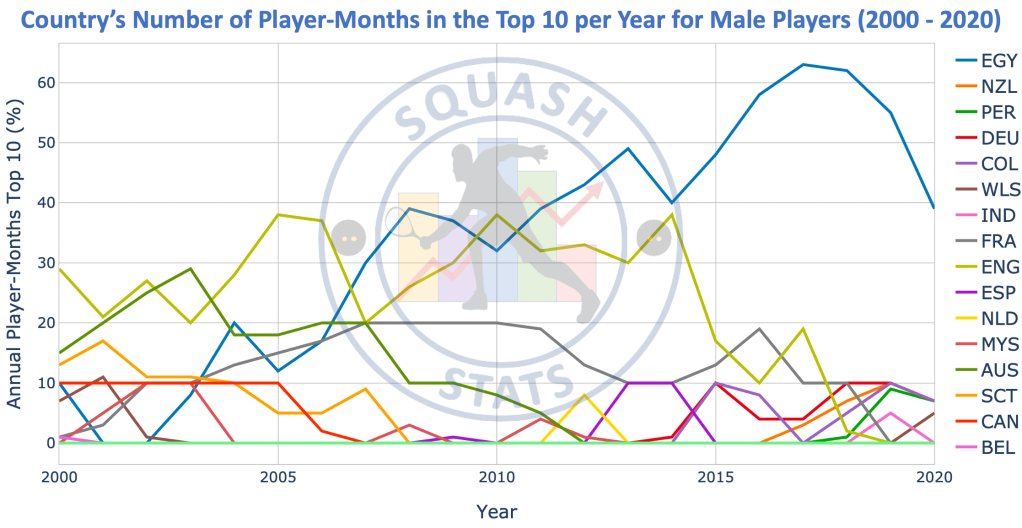
The female plot is also interesting in that the rise and decline of specific nations can be seen. The graph starts in 2000 where England has approximately 60% of the player-months. As a point of reference, this is the same rate of dominance that the male Egyptians currently (September 2020) possess. In December 2000, England had 7 players in the top 10 PSA ranks. This is the most held by any country. From 2000 – 2014 England continued to be the dominant country in the top 10. However, it can be clearly seen that their dominance decreased year-over-year. As their number in the top 10 continued to drop, in 2015 their dominance was over taken by Egypt. In 2016 & 2017 there is a brief reprisal due to Sarah-Jane Perry and Alison Waters joining Laura Massaro in the top 10. England’s current standing is that Sarah-Jane Perry is the only player in the top 10 and given her consistency, England’s player-month is expected to hold at ~10% annually.
Once again the rise of Egypt is clearly visible. It started in 2008 with Omneya Abdel Kawy consistently being in the top 10 ranks. Over the next 7 year the dominance of Egypt grew and grew, surpassing England in 2015 at which point Egypt had over 40% of all player-months in the top 10. This sudden increase in 2015 was due to Nour El Tayeb, Nouran Gohar and Omneya Abdel Kawy joining Nour El Sherbini and Raneem El Welily in the top 10. Since then Egypt has maintained this 40% average during the last 5 years. Even after the recent retirement of Raneem El Welily, another Egyptian, Salma Hany, almost immediately enters the top 10. In addition, with four Egyptian players in the 11 – 20 ranks (Yathreb Adel, Rowan Elaraby, Nadine Shahin and Nada Abbas), the Egyptian dominance will most likely continue for some time.
From 2001 to 2012 Australia (yellow) maintained a consistent ~20% of the player-months each year in the top 10. This is mainly due to Australia consistently having two players in the top 10. These players consisted of Sarah Fitzgerald, Rachael Grinham, Natalie Grinham and Kasey Brown. The sudden drop in from 2013 to 2015 is due to Rachael Grinham, Kasey Brown and Natalie Grinham dropping out of the top 10 in that order. Since then Australia has not had a top 10 player.
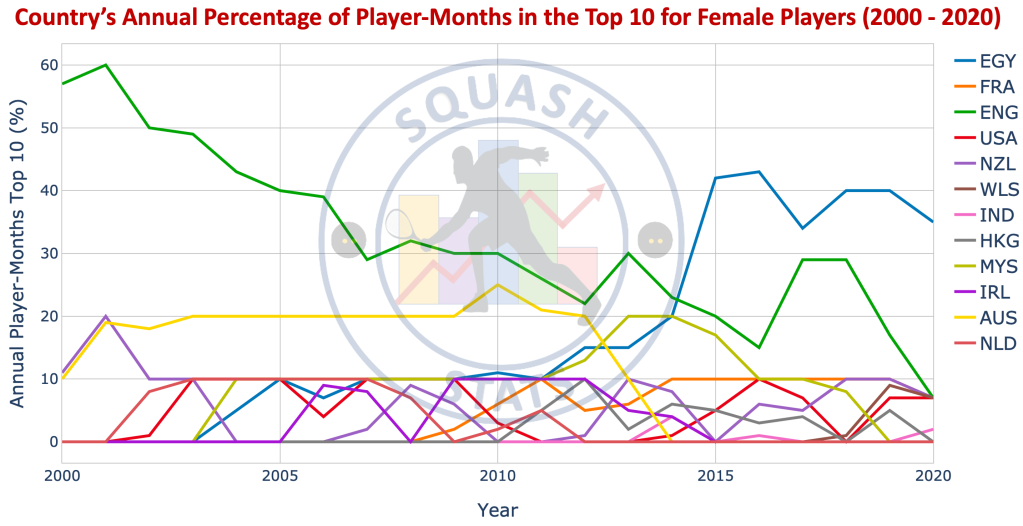
The above graphs can be cross referenced with the male animation and female animation for the variation of the top 10 ranks. The rise and fall of the countries in the above plots coincided with the entry and exit of certain players from the top 10 in the video animation.
It is also worth looking at each of the top countries (England, Egypt and Australia) individually so that the rise/fall of each gender can be compared. This is illustrated below where blue and red lines represent the percentage of player-months for male and female categories respectively.

Rankings of the Top 10 players
The following links to animations provide an interesting overview of the male and female top 10 ranking over the last 20 years. Click on the two links below to enjoy the animations.
Variation of the Male Top 10 PSA Ranks 200 – 2020
Variation of the Female Top 10 PSA Ranks 200 – 2020
It is difficult to compare the ranking careers of all top 10 players as everyone has had a different and unique path to the top 10, at different points in their career, and even in different eras. We therefore take a look at the rankings as a function of a players’ age. The following plots illustrate all the career rankings of the top 10 players as a function of their age. All players are shown in grey and the average path followed by the top 10 players is indicated blue for male players and red for female players. From the grey lines it can be seen when players, in general, rise and fall in rankings, often suffer injuries and retire. In the male plot it can be seen that the average male reaches a peak performance ranking between the age of 25 – 30, whereas female players have a longer period of time, 22 – 33 years of age.


The Age of Top 10 Players
The previous sections explored the career rankings of players as a function of their age. Here we take a closer look at the age of the top 10 players of the last 20 years. In the graphs below, the dotted lines indicate the maximum and minimum ages of the top 10 ranks for a given year, while the central coloured line indicates the average age for that given year. In the male plot it can be seen that the male average age increased from 26 years to 31 years during the 2000 – 2014, but then decreased and now maintains a level average age of 29 years. There is also a substantial increase in maximum age in the top 10 from ~30 to 37 years of age, which slightly decreased in recent years due to the retirement of several of the older top 10 players (Nick Matthew, Ramy Ashour). The increase and decrease of the lines coincide with older players leaving the top 10 to and younger players reaching the top 10
In contrast to the men’s average age increasing, the average age in the top 10 female players has actually decreased.


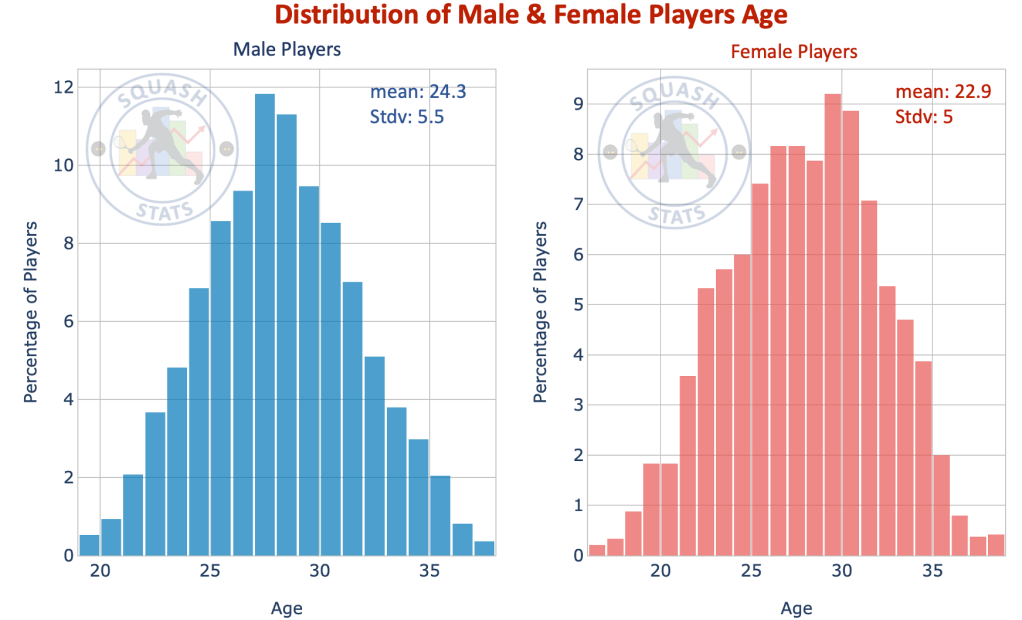
Going from Top 10 to Number 1
In the above analysis it is clear that there are many players that have made it into the top 10 ranks. But how high did they climb in the top 10? The following plot explores the maximum rank reached by the top 10 players, whereby the players’ highest rank is plotted in the x-axis and the percentage of players who achieved that rank as their highest was is plotted on the y-axis. In general, you can see that the number of players increases as you get closer and closer to the number one spot. This essentially means that the probability of reaching lower and lower ranks (towards the number 1 spot) increases. So if a player reaches the top 10 ranks, that player is most likely going to reach a lower rank. Interestingly, there is a marked increase in the percentage of players with number 1 rank (x-axis = 1) as their highest rank. This indicates that if you reach the top 10, there is a 30% probability that you will become number one at some point. There is also a marked decrease in players that have the highest rank of number 2. This may be due to the fact that there is often a rivalry between the top 2 players resulting in them trading positions in a cyclical manner. This leads to the fact that if you make it to number 2, there is a high probability that you will make it to number 1. This theory is validated in the below tables.

The following analysis looks at previous rankings within the top 10 to determine the probability of a player reaching a certain lower rank (final rank) given their current rank (starting rank). The y-axis on the left side is the starting rank and the x-axis on top is the final rank. For example, if we look at a male ranked in 10 (i.e. y-axis = starting rank = 10), then the table tells us that this player has an 88% probability of reaching rank 9 (x-axis = final rank = 9), an 82% probability of reaching rank 8 and so-on and so-forth. In the male table one can see that the final ranks of 1 and 2 are always the same. This means that all players that reach the number 2 spot, also make it to number 1. For both genders, the most difficult single rank step is going from rank 3 to 2.
By comparing the number one ranks, for each starting rank it can be seen that the probability of reaching number one is lower for female players when compared to male players. This is also what we say above at the very beginning as there were less female number one players than males.

It is worth taking some time to look at the above tables and running a few scenarios. Here are a few to help you further understand the usage of the table
- If a male player is ranked at 10, he has a 32% probability of reaching number 1
- If a female player is ranked at 10, she has a 23% probability of reaching number 1
- If a male player is ranked at 5, he has 52% probability of reaching number 1
- If a female player is ranked at 5, she has a 38% probability of reaching number 1
Outlook
Presented in this article is a summary of the top 10 ranks between the years 2000 – 2020. As mentioned previously, the data is not reliably available pre-2000. However, it is possible that this data will be available in the very near future, in which case this article will be updated. This would give us a much better picture of how the top 10 ranks varied over the entire PSA lifetime and include some of the players that are currently omitted due to the time restriction on the data.
This article also started to explore how the dominance of certain countries can be measured by looking at the top 10 ranks. This turned out to be a fruitful exploration which will be continued and expanded upon at a future time. We have studied the number 1 players, top 10 players, with a further analysis we hope to have a statistical and mathematical method of determining the Greatest Of All Time PSA squash player.

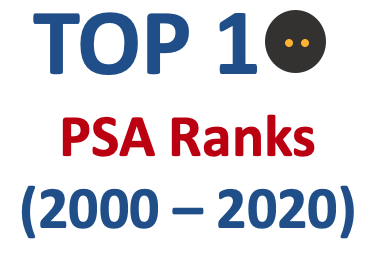
Well done!
LikeLiked by 1 person
GREAT INFORMATION THANK YOU!
LikeLike
We would like to use material from your website within our International Examination Papers. Can someone please contact me about this using the reference Proj 8 2022? copyright@cambridgeinternational.org
Many thanks.
Diane Hudson-Sharpe
Copyright Administrator
Cambridge University Press & Assessment
The Triangle Building
Shaftesbury Road
CAMBRIDGE
CB2 8EA
LikeLike